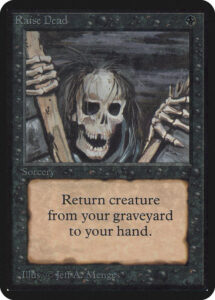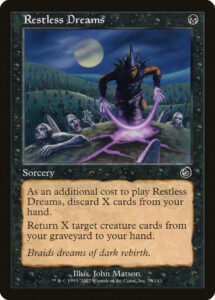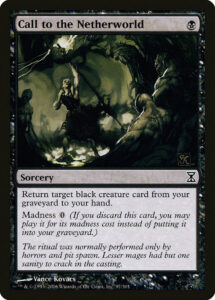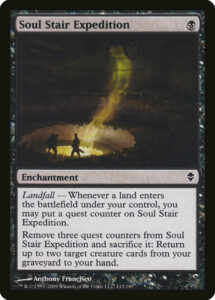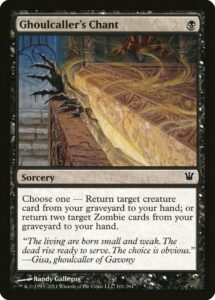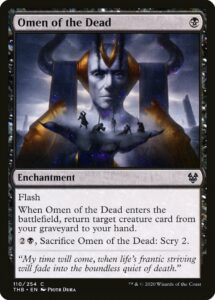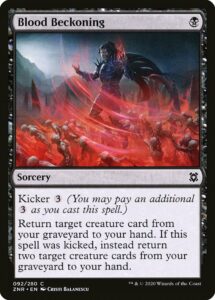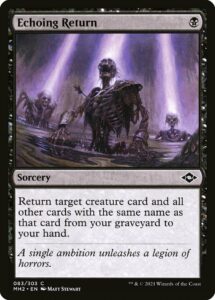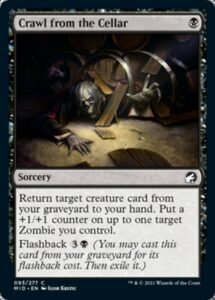There have been twelve Raise Dead effects in Magic’s history. Sure, there have been plenty of ways to return creature cards from your graveyard to your hand, but only twelve do it for just one mana. Innistrad: Midnight Hunt introduces Crawl from the Cellar, which is one of several one mana cards that outclass their forebears—Candletrap, Consider, Fading Hope, Eaten Alive, and Play with Fire.
I love it when designs can not only be directly compared to each other, but be used to demonstrate trends over time. Magic has gotten stronger over time, and while it would suffer if every card always had its effects maximized, it’s exciting knowing the full extent of what is possible for an effect at any given cost. Specific environments can combine with skillfull Play Design to squeeze a tiny bit more value into a spell worth ~0.90 mana. Today we’ll track the history of the evolution of a single effect and what it shows about Magic as a whole.
In the beginning, there was Raise Dead. It was simple, evocative, and effective. Narratively, it wasn’t entirely clear the difference between this and Animate Dead, but that’s one of Magic’s many hand-waves that last to this day.
This wasn’t an especially powerful effect in a format with generally weak creatures and spells like Ancestral Recall, but it didn’t need to be—Magic was in its infancy and no one could have imagined how impossible successful it would be even by 1994. As time went on, creatures steadily grew in strength and spells gradually dropped in power level to match them. As that happened, Raise Dead effects became increasingly desirable.
Over the years we not only saw many reprints of Raise Dead, but also functional reprints Return to Battle and Disentomb. They didn’t rock the boat because they didn’t need to. Most of the time, effects are better when they’re simple rather than utterly optimized.
As with many things Odyssey block, Restless Dreams is very much a Spike card. While there’s a high ceiling here—you can cash in three lands for three creatures—the floor is incredibly low, trading in two cards just to get the already cheap effect of one Raise Dead. This is neither simple nor appealing and doesn’t even work to enable Threshold, but it is a puzzle to be solved, such as converted card disadvantage into advantage with Flashback and Madness cards.
Time Spiral plays with Raise Dead by combining a major restriction with a decent advantage. We’ve yet to see an actual improvement on Raise Dead, but we’ve now seen two experiments in laterally changing it into a different kind of card.
I’m fine with this design. I love Madness more than most, which scores this some points even though the color restriction limits its use and the kinds of decks that want to use it. Frankly, I wouldn’t be surprised if Modern Horizons 3 gives us just Disentomb with Madness 0, no strings attached.
Soul Stair Expedition is yet another lateral exploration. On its own, it does nothing, but it’s the first Raise Dead to promise easy card advantage (Call to the Netherworld and Restless Dreams could do it, but required more support than just making a few land drops).
I like this design. Not only does it introduce Landfall, a brilliant mechanic that’s fairly specific to Magic’s mana system, but it’s proactive and aspirational. Most Raise Deads sit in your hand, waiting for the right time to be cast and adding their cost to the rebought creature’s (assuming you want to play it immediately). Here, you pay the cost in advance. The only strike I have against it is that your opponent is in on the fun—perhaps we’ll one day see a future version that uses Foretell instead to discount the cost without foisting awkward decisions on to your opponent.
Ah, original Innistrad. Alongside its many innovations, it also had the subtle yet powerful Ghoulcaller’s Chant. Finally, Magic created a strictly better Raise Dead rather than a twist with advantages and disadvantages. I love how simple and aspirational it is.
As long as you have one dead creature, this is Raise Dead, but build your deck around one of the set’s five main tribes (the one most centered on returning from the dead, of course), and you’ve built your own Thoughtcast. It’s a design so nice they made it twice, with Ixalan’s March of the Drowned tweaking it to fit a differently tribal framework. This also inspired cards like Grim Captain’s Call and Return from Extinction, but those aren’t true Raise Deads, so we’ll move on.
The Omen cycle from Theros Beyond Death was masterly. Each color had access to a card which interacted with Devotion, Constellation, flash-matters, and sacrifice-matters. While Omen of the Sea stole the show in Standard alongside Yorion, Sky Nomad, Omen of the Dead was an eminently serviceable card in a Limited format where black outclassed all other colors.
I love two innovations here: making Raise Dead instant speed and using the affordance of it being an enchantment to add a second mana cost for additional value. While Ghoulcaller’s Chant was restrictive in its boon, Omen of the Dead is all upside (even if will never be an actual two-for-one). It’s a different take on buffing Raise Dead, and adding mana for a bonus would make a second appearance in 2020.
Another return to Zendikar brought another Raise Dead paired with a quintessential mechanic. While Blood Beckoning isn’t as mana efficient as Ghoulcaller’s Chant, it’s far more flexible to use. Innistrad’s design is optimized for Constructed play, while Zendikar Rising’s is ideal for Limited.
Kicker is a fantastic way to add power to cheap cards. Normally, it gives you an option for early and late in the game, but Raise Deads only start working in the middle of the game. Instead, Blood Beckoning offers a tradeoff between card advantage and tempo—would you rather cast the creature immediately or can you afford to take a little more damage and get two back? It’s a test, but the modes are easy enough to understand that it’s not an especially challenging one. In a game as complicated as Magic, it’s important to craft cards that let your players feel smart while also letting your more competitive players optimize their decisions.
It’s Ghoulcaller’s Chant with a higher ceiling and an even greater restriction. The puzzle is easier to solve, but it’s not an especially interesting one. There’s a bit of play here in Limited, since you’re unlikely to have duplicates of your best creature, so you can either rebuy your busy creature or get card advantage with something more middling. Overall, it’s a fine twist, though the inflexibility makes me less enamored of it than the other options in 2020-2021.
And finally, we get to the newest and likely most powerful ever twist on Raise Dead. This both improves upon the original design by adding about ~0.25 mana worth of effect and has a cut rate Flashback cost to boot. I wouldn’t be surprised if this is a bit too much power in a common, especially in a format where zombies is one of the strongest archetypes. A +1/+1 counter is a dangerous thing to give out for free on a one mana card, especially one that already outputs a card’s worth of value.
Yes, there’s room for a bonus on Raise Dead and drawing two cards (sometimes) is more powerful than drawing one card and getting a +1/+1 counter (sometimes). But the ease of use and unusually cheap Flashback cost suggests Wizards managed to squeeze a little more than one mana’s worth of value onto a spell that’d already be playable without Flashback. Perhaps this is the absolute upper bound of how powerful Raise Dead can be for one mana under Magic’s current design paradigm. But perhaps in a decade, there will be even more room to optimize Raise Dead. Or perhaps this will stand the test of time and never be surpassed.
Staple effects like this are constantly reinvented, and by examining them, we catch of glimpse of Magic’s past, current status, and possible future. For all you aspiring game designers or design enthusiasts out there, I encourage you to pick a staple effect and just track its history. It could be as simple as a Shock or as varied as giant, flying demons. There’s so much to learn by simply seeing the same concept remixed again and again. Sometimes simplicity is traded for power. Some keywords allow for elegant power, while others are wordy. Some formats allow for novel designs or make certain benefits easier or harder to utilize. No matter the design, every single card has a wealth of lessons to teach.
And, as always, thanks for reading.
Zachary Barash is a New York City-based game designer and the commissioner of Team Draft League. He designs for Kingdom Death: Monster, has a Game Design MFA from the NYU Game Center, and does freelance game design. When the stars align, he streams Magic (but the stars align way less often than he’d like).

